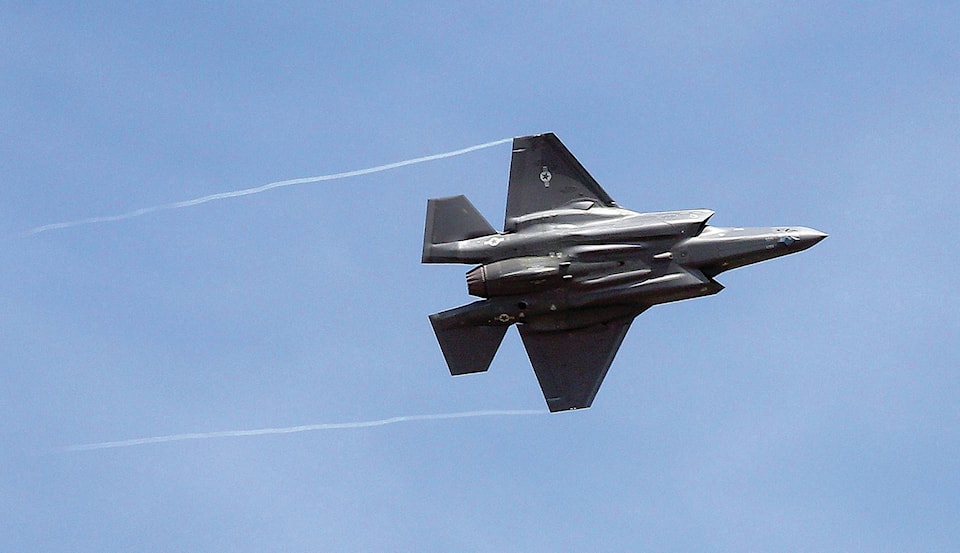OTTAWA — U.S. officials have threatened to pull the F-35 out of the competition to replace the Royal Canadian Air Force’s aging CF-18 fighters over the Liberal government’s plan to ask bidders to re-invest some of the giant purchase contract in Canadian industry.
The warnings are in two letters sent to the government last year and obtained by defence analyst Richard Shimooka. They were released in a report published Monday by the Macdonald-Laurier Institute think-tank.
They say the requirement is incompatible with Canada’s obligations as a member of the group of countries working together to develop the F-35 stealth fighter in the first place.
While the re-investment requirement is standard for most Canadian military procurements, the U.S. officials note Canada agreed not to include it when it signed on as one of nine F-35 partner countries in 2006.
Companies in those countries must instead compete for work associated with the plane — only companies from those countries are eligible, but they’re supposed to compete on equal footing. The U.S. officials say conditions on bidders that would privilege Canadian companies will mean the F-35 won’t be entered in the race.
The F-35, which is built by Lockheed Martin, had been expected to go up against the Eurofighter Typhoon, Saab Gripen and Boeing Super Hornet for an 88-plane procurement worth about $19 billion. French company Dassault pulled its Rafale from contention late last year.
“In summary, we cannot participate in an offer of the F-35 weapon system where requirements do not align with the F-35 partnership,” U.S. Vice-Admiral Mathias Winter, program executive officer for the Pentagon’s F-35 office, wrote on Dec. 18. “Such an offer would violate (the F-35 agreement) and place the entire F-35 partnership at risk.”
In his letter to Paula Folkes-Dallaire, senior director of the fighter-jet program at Public Services and Procurement Canada, Winter asked for clarity by Jan. 31 as to the government’s decision on the re-investment requirements.
Winter’s letter followed a similar one from Ellen Lord, the Pentagon’s head of military procurement, on Aug. 31, 2018.
Requests for comment from the federal government and the F-35 project office in Virginia were not immediately answered.
But government and industry sources, speaking on condition of anonymity because they were not authorized to comment publicly, have confirmed to The Canadian Press that the issue remains unresolved, which is causing frustration and anxiety and will almost certainly delay the start of the competition beyond the end of May.
Stephen Harper’s Conservatives first announced plans to buy 65 F-35s without a competition in 2010, but backed off that plan over questions about cost and concerns over the Defence Department’s tactics in getting government approval for the deal.
During the 2015 federal election campaign, Justin Trudeau’s Liberals promised they would immediately launch an open and fair competition to replace the CF-18s, but not buy the F-35.
The Trudeau government has since said the F-35 will be allowed to compete while officials had been expecting to finally launch that competition in the coming weeks.
That the re-investment requirement remains unresolved is both surprising and unsurprising given defence experts have long warned it would be a significant obstacle to running a fair and open competition that includes the F-35.
Canada, which has already contributed roughly $500 million over the past 20 years toward developing the F-35, could in theory quit as a partner country, but would have to pay more for the stealth fighters if the F-35 won the competition.
Canada could also be on the hook for hundreds of millions more in development fees despite quitting the program, while Canadian companies would not be allowed to compete for work related to the aircraft.
In a recent interview, the Department of National Defence’s head of military procurement, Patrick Finn, said the government is trying to strike the right balance between military and economic priorities when it comes to the fighter-jet competition.
“The feedback we’re seeing from some suppliers some are quite content, some would like to see some more flexibility in other areas,” he said.
“So it’s making all of that work, respecting (companies’) strengths, keeping everybody in the competition and doing it in a way that brings the right capability to the air force for decades to come.”
—Follow @leeberthiaume on Twitter
Lee Berthiaume, The Canadian Press
